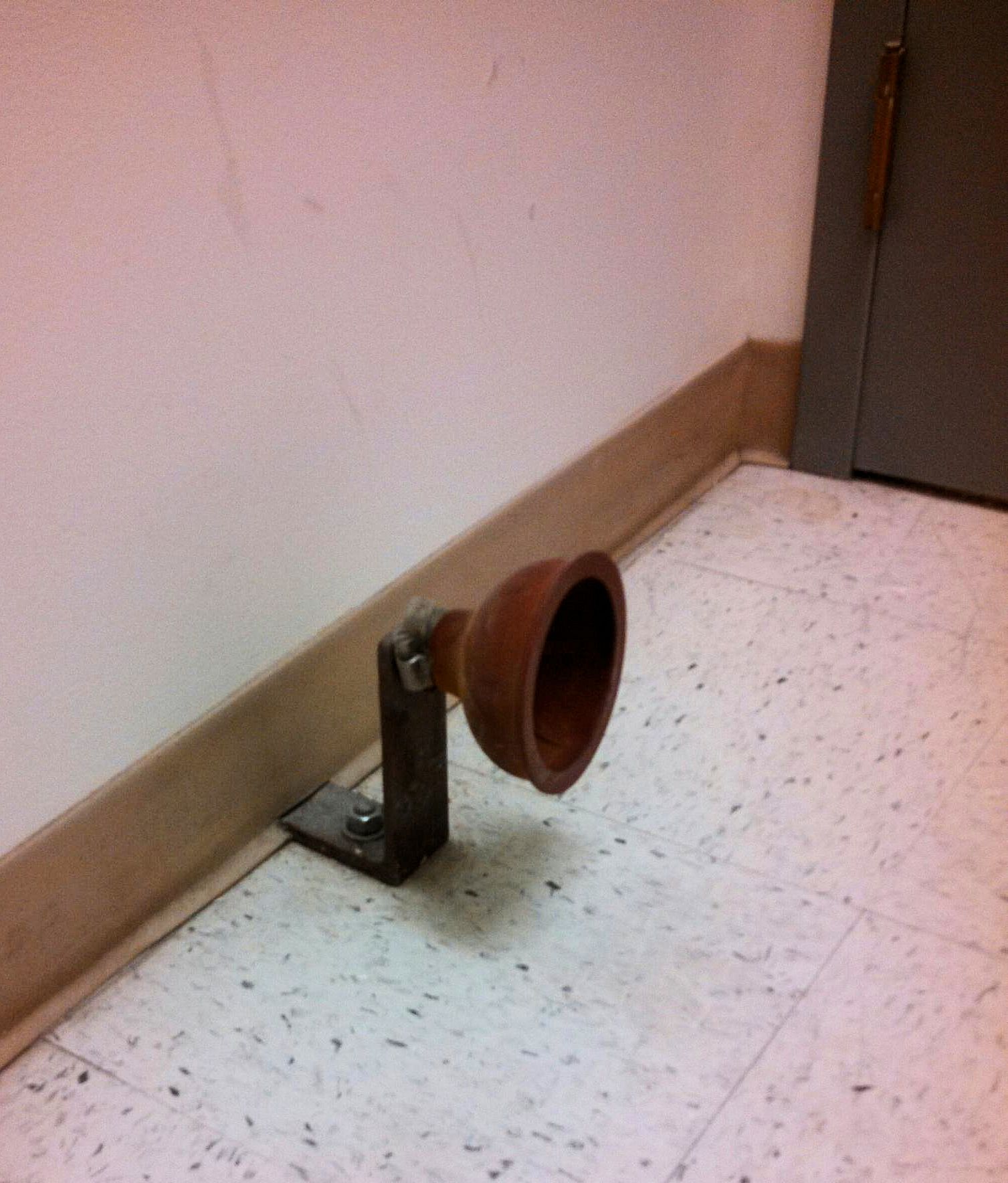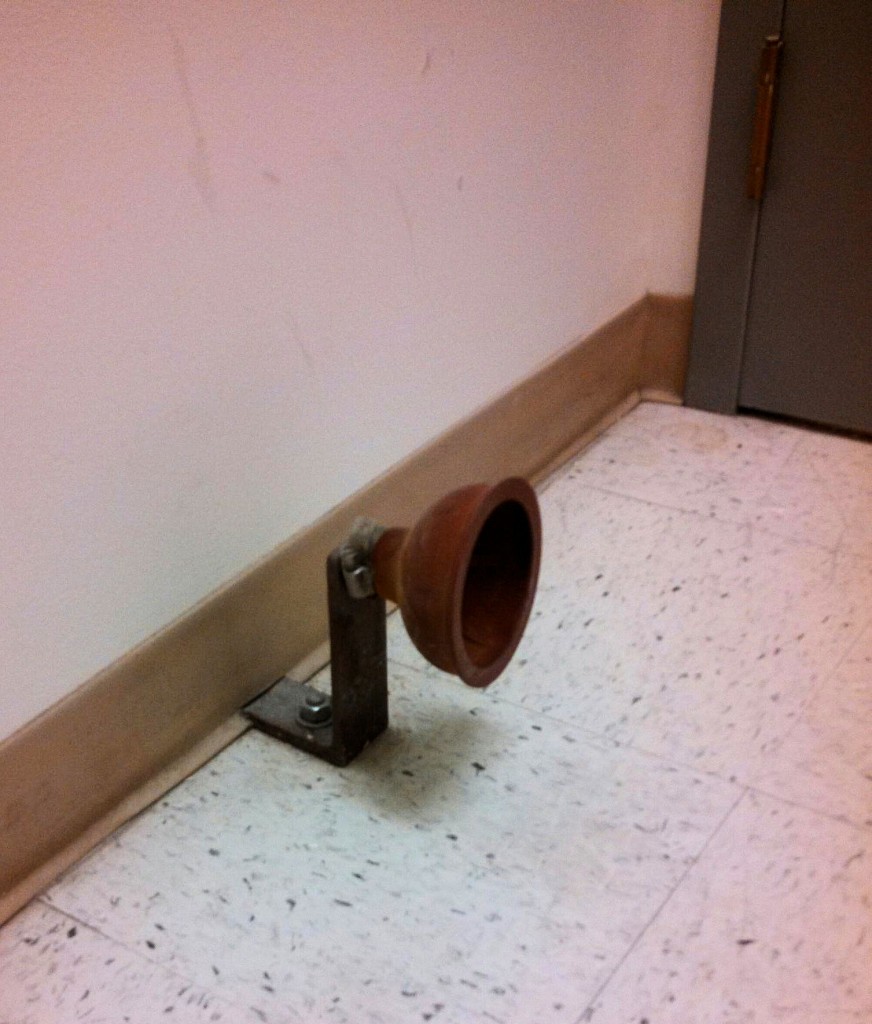When this great Fixed-it Friday photo showed up in my inbox (sent by John Emry), it made me think about the “why” behind the creative modification. This improvised hold-open device has been retrofitted on all of the stair doors in this particular school. Presumably, the teacher leads her line of students down the corridor, pushes the door open until the plunger engages, and the group of students passes through the opening before the door closes. Ingenious! Except that it isn’t listed for use on a fire door.
But there is already a product in existence that will perform this function, without the expense of electronics – a delayed action door closer. The delayed action feature, which has to be part of the original closer and can’t be retrofitted, is a very inexpensive solution. It will hold the door open for up to a minute (or two, depending on the product), by restricting the fluid flow for a short time. The delay only engages when the door is opened to the fully-open position, so under normal use there would not be a delay. But when the teacher pushes the door all the way open, she will have a minute or so to move her class through the door. This would make it easier for the kids to pass through the opening, and would also save wear and tear on the door, frame, and hardware (have you ever seen a group of middle schoolers make their way to gym class?).
From a code standpoint, I can’t find anything in the codes that would prevent the use of a delayed action closer on a fire door. The only references to closing speed/time are a minimum of 5 seconds for doors on an accessible route, and a maximum delay of 10 seconds before an automatic-closing door begins to close after released by the fire alarm. Door closers with delayed action are not automatic-closing doors, they are self-closing, so this section of the code would not apply. I’ve asked several AHJs and they did not have a problem with having this short delay on a fire door, especially because it only engages when the door is purposely opened to the fully-open position.
Fire doors can be difficult for kids to open because of the increased opening force that is typical for a fire door. And the doors must be closed during a fire to work as intended and deter the spread of smoke and flames. If the door is not equipped with a hold-open released by the fire alarm, it is often propped open with a wedge. If a short delay would remove the temptation to prop the doors open in a way that is not code-compliant, that’s a great improvement.
Should we be specifying delayed action closers on stair and cross-corridor doors in schools? If you know any teachers, ask them if this would help, and let me know!
You need to login or register to bookmark/favorite this content.







if hardware consultants were school facilities personnel, then the closer would be adjusted correctly for the occupants. I found that most people, including many in the hardware industry in my last years in the business, had no idea what the DA was for and how to adjust it.
when I was working on a hospital project I would always use DA on doors over 36″, even on stair doors. my reasoning is that wide doors have material on carts going thru them and it would help for the door to stay out of the way. and when I would walk the project at the end of the project, I would always point out that the doors could be adjusted to the owner’s requirements.
never had seen the plunger hold open – VERY INTERESTING!!!!!
Hi Bruce! I usually use them for storage rooms and tub rooms in health care, but honestly, I never thought about using them in schools. I’ll be interested to see the feedback.
do you have a link to a delay device, with specifications?
Hi Charles –
It’s just an option that can be added to many closers (before ordering, not in the field)…there’s a description of it if you follow this link: http://us.allegion.com/irstdocs/catalog/109514.pdf and go to the top of page 19.
Most posts on this blog are very interesting and useful. Among them, this is one that add a touch of sensitive intelligence by addressing kids’ opening force. Thank you so much Lori for spreading such culture of “raised attention threshold” (threshold, what else?), best wishes for the winter’s holidays! 🙂
Thanks Bruno! Happy holidays to you too!
That plunger H.O. is pure genius!
And it’s fusible to boot! 🙂
😀
I’ve put the DA feature on the interior door of vestibules. Lots of people passing thru at certain times but we don’t want the door stuck in the open position. Not so much on exterior doors where wind can prevent the door from closing if left open.
Good idea! I think I have been under-utilizing this feature!
so I guess closers are never fire tested???
Just cycled 1,000,000 or so times???
I’m not sure exactly what the procedure is for testing closers (I will find out), but when I attended a fire test of a wood door, cycling the door (opening/closing/latching) was not part of the test. It was just a closed door that was exposed to fire in the test furnace.
Here’s what I found out Charles. There are 2 tests involved…
1. Durability cycle test to UL 228
2. Fire test to UL 10C. This test is done only with the closer outside of the furnace, to determine if flame-through occurs, or if the fluid ignites and spreads fire on the non-fire side of the door.
Thank you for the info
Question of clarification:
Lori: “It’s just an option that can be added to many closers…”
Added to the closer after it has been sold to an end user ?
Hi Ron –
I don’t know of any manufacturers that can add the delayed action feature in the field, unless you want to replace the cylinder. It said that in the blog post but I just edited the comment response to make sure it’s clear.
– Lori